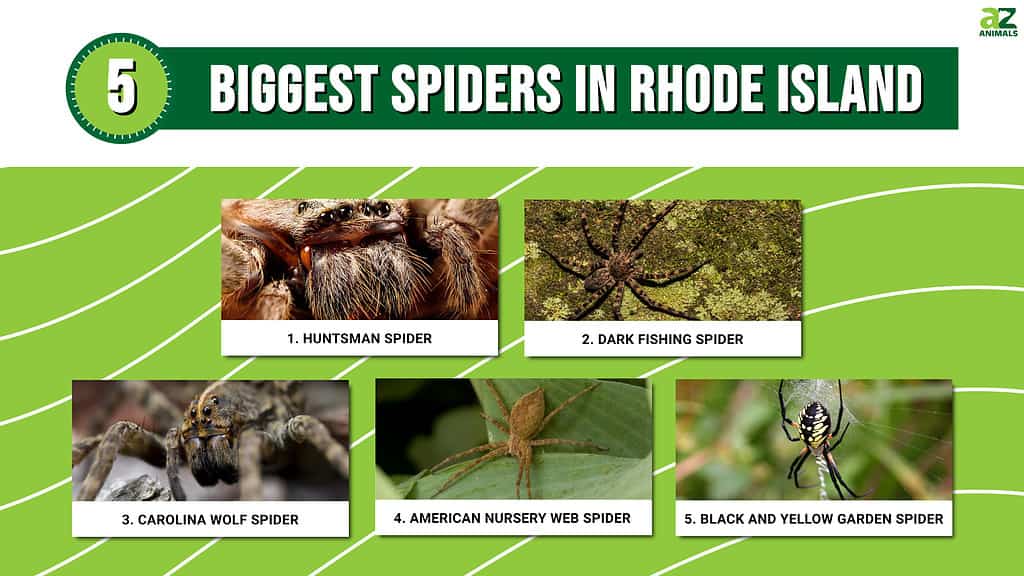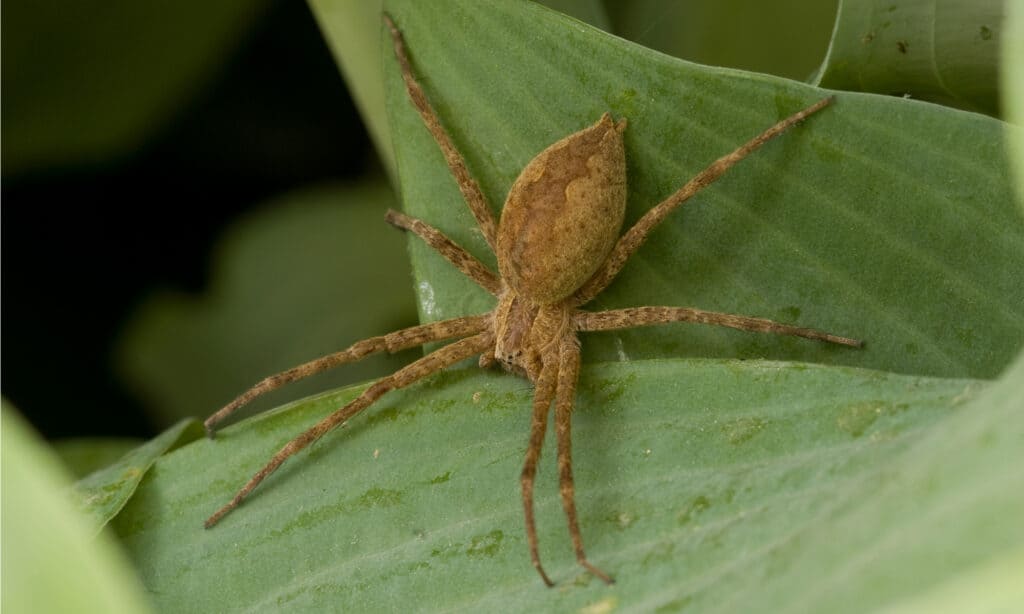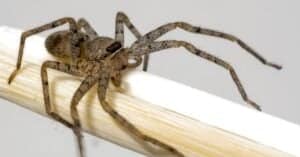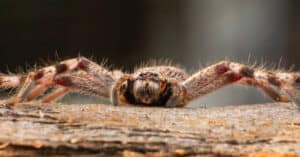Rhode Island is the smallest state in the United States, but that doesn’t mean it’s not rich in animal life. Surprisingly, this part of New England is home to some large species of spiders found in the Northeast. Today, we’re going to shed light on five of the biggest spiders in Rhode Island.
We’ll teach you where they prefer to live and if they can cause you any bodily harm. Of course, we’ll also show you just how big they can get! So, let’s see what arachnids this diminutive state has within its borders!

What Are the Biggest Spiders in Rhode Island?
Unlike some of the other states in New England, Rhode Island has at least five species of spider that can reach three inches in length. Of course, we’re measuring the total length of the arachnids and not the body length.
Also, to help maintain the diversity of the list, only one member of each species was represented on this list. Without further ado, let’s consider the biggest spiders that are found in this beautiful state.
5. Black and Yellow Garden Spider

The black and yellow garden spider is a common sight throughout much of the United States.
©iStock.com/AwakenedEye
| Scientific Name | Size | Danger to Humans |
|---|---|---|
| Argiope aurantia | 0.2-3 inches | Rarely bites humans, but it may cause pain and swelling. |
The black and yellow garden spider is a beautiful arachnid with patterns of vivid yellow and black on its body. The cephalothorax is often gray, but the abdomen is black with yellow markings along the outside. It may have gray patterns on the abdomen along with yellow and black, too.
The legs of black and yellow garden spiders are usually light brown near the body and then banded black and brown down their length. These spiders are often listed as growing 1.1 inches, but that’s just their body length. Their legs are quite long and give them a total length of about 3 inches.
Furthermore, the spiders are known for making a massive web that can measure several feet across that has a thick, zig-zag line in it called a stabilimentum. These spiders are beautiful and easy to spot. Although they don’t often bite humans, they can deliver a bite that inflicts pain and swelling on the victim.
4. American Nursery Web Spider

Male American nursery web spiders will tie females’ legs during mating to avoid being eaten afterward.
©SDeming/Shutterstock.com
| Scientific Name | Size | Danger to Humans |
|---|---|---|
| Pisaurina mira | 1-3 inches | Has a bite that is mostly harmless to humans, with pain and swelling common. |
The American nursery web spider gets its name from its habit of building a “nursery” made from its web to house its eggs when they’re close to hatching. Aside from that, this spider can resemble many others since it is brown and tan.
American nursery web spiders often have a dark stripe going down the middle of their bodies and legs that alternate between brown, light brown, and tan in ill-defined bands. These spiders can bite humans, causing pain and swelling in the bite area. Yet, unless a person is allergic to them, the bite is not that serious.
You’ll most likely find these animals outside near homes or in tall grass, but they have a wide range of suitable habitats.
3. Carolina Wolf Spider

The wolf spider is one of the largest spiders in the U.S.
©Will E. Davis/Shutterstock.com
| Scientific Name | Size | Danger to Humans |
|---|---|---|
| Hogna carolinensis | 2-4 inches | The bite causes local pain and swelling. |
The Carolina wolf spider is the largest wolf spider in the U.S., and it can grow upwards of 4 inches long when you count its leg length. Yet, this spider’s length is not all from its legs. It has a body that can measure over an inch long, making it easy to see the mouthparts and large eyes that strike fear in so many people.
This spider is large in its own right, but it can look even more imposing if a large female is carrying her young on her back. This spider is often black, brown, and gray, making it hard to spot them in the woods and burrows in which they live. Wolf spiders often have light markings around the outside of their cephalothorax along with a light stripe running down the middle of their bodies.
Several myths about these spiders persist, including that they are deadly to humans. They are not very dangerous to humans unless an individual is allergic to their venom. If they bite a person, they will most often suffer from pain and swelling similar to what they could expect from a bee sting.
2. Dark Fishing Spider

The dark fishing spider is not found near water as often as other members of its genus.
©iStock.com/JasonOndreicka
| Scientific Name | Size | Danger to Humans |
|---|---|---|
| Dolomedes tenebrosus | 3.5-4.5 inches | Can bite humans and cause a reaction similar to a bee sting. |
Despite its name, the dark fishing spider is not always found close to water. Instead, it’s possible to find them in the woods. These spiders are usually brown, tan, and black, with dark patterns on the body. Their legs have light and dark chevrons running down the upper part of their legs. This pattern evolves into color bands on the latter portions of the legs.
Despite reaching a size of 4.5 inches, the dark fishing spider is not dangerous to humans. On the rare occasion that a person is bitten by one, the dark fishing spider’s bite is said to be about as bad as a bee sting.
1. Huntsman Spider

The huntsman spider is fearsome in looks and behavior.
©Paul Looyen/Shutterstock.com
| Scientific Name | Size | Danger to Humans |
|---|---|---|
| Heteropoda venatoria | 3-5 inches | Have a mildly venomous bite that can cause swelling and headaches |
You can call it the cane spider, the crab spider, or the huntsman spider, but it’s big any way you look at it. In fact, this is arguably the biggest spider in Rhode Island.
These spiders tend to have large brown bodies that measure up to 5 inches long! They can integrate other colors as well, including gray and black. Like the wolf spider, the outer portion of their cephalothorax is a light band with a dark middle, but these spiders also have a light area behind their eyes and a dark stripe on the abdomen.
The dangers of these spiders are not fully understood. Some sources claim their bites can cause swelling, headaches, sweating, and pain. Others claim their bites just cause pain and swelling. Either way, you aren’t likely to be bitten by these spiders so long as you give them some space.
Now that you know about the biggest spiders in Rhode Island, you should know that they’re not the scariest ones. Instead, you need to watch out for the brown recluse and the black widow, two spiders with very harmful bites and the potential to cause lasting damage.
Summary of 5 of the Biggest Spiders in Rhode Island
| Rank | Spider | Size |
|---|---|---|
| 1 | Huntsman Spider | 3-5 inches |
| 2 | Dark Fishing Spider | 3.5-4.5 inches |
| 3 | Carolina Wolf Spider | 2-4 inches |
| 4 | American Nursery Web Spider | 1-3 inches |
| 5 | Black and Yellow Garden Spider | 0.2-3 inches |
The photo featured at the top of this post is © Paul Looyen/Shutterstock.com
Thank you for reading! Have some feedback for us? Contact the AZ Animals editorial team.






